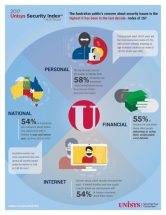Australians are selective about when they support sharing personal data with government agencies and commercial organisations via the Internet of Things, according to the 2017 Unisys Security Index.
The vast majority of Australians, 82 per cent, support using a button on their phone or smartwatch to alert police to their location during emergencies. Yet only 35 per cent support police being able to monitor fitness tracker data anytime to determine their location at a certain time.
The findings indicate that Australians will embrace IoT where they see a compelling reason such as personal safety and medical emergencies, but concerns about privacy and data security mean they want to be able to control which organisations can access their data.
Most Australians support (75 per cent of respondents) medical devices such as pacemakers or blood sugar sensors automatically transmitting significant changes to a patient’s doctor, and sensors in luggage to advise passengers if their luggage has been unloaded and what carousel it will be on (65 per cent).
Yet less than one in three people support using a smartwatch app to make payments (29 per cent), or a health insurer accessing fitness tracker data to determine a premium or reward customers for good behaviour (26 per cent).
The Internet of Things (IoT) refers to devices, sensors or computer systems that can connect and exchange information with each other using the internet. Unisys examined consumer reaction to the trend as part of a global study that gauges the attitudes of consumers on a wide range of security issues. The study polled 1,002 adults in Australia during April 2017.
“These findings highlight that when it comes to personal data there is a very delicate balance between privacy, security and convenience – even for organisations generally trusted by the public,” said John Kendall, director of border and national security programs at Unisys. “For example, people are happy to use their smartwatch to alert police to their location when they need help, but they don’t want police to freely access that data at any time – they want to control when they share their data.”
What are the barriers to IoT?
Privacy and security concerns are key reasons Australians do not support IoT. In particular, if they do not feel it is a compelling enough reason to share their data or if they do not want an organisation to have such data about them. Data security is the biggest barrier cited for not supporting a smartwatch payment app.
Richard Parker, vice president financial services at Unisys Asia Pacific said: “To address consumer concern around data security of smartwatch payment channels, banks need a multi-pronged approach that spans technology and policies to secure the data, as well as reassuring customers by communicating the steps taken by the bank to protect them – a fine line in delivering a frictionless customer experience whilst making sure they are secure.”
Devices on government agency personnel are supported
Wearable biometrics are part of the IoT phenomenon: wearable technology that analyses human characteristics to confirm an identity or monitor critical medical data.
There is strong support, three in four Australians, for police or border security staff wearing facial recognition body cameras to identify criminals or terrorists who are on watch lists; and medical sensors transmitting any significant changes to a patient’s doctor.
Fingerprint scans on smartwatches could address the security concerns around smartwatch payment apps. “Approximately half of consumers support a fingerprint scan to control access to data on a smartwatch (52 per cent) or to authorise a payment from the smartwatch (48 per cent). This is a clear signal to banks that biometrics could help alleviate consumer concerns about smartwatch payment channels,” said Mr Parker.
While 50 per cent of Australians support airline staff wearing facial recognition glasses to verify the identity of passengers boarding aircraft at airports, only 29 per cent support the same glasses being used to identify VIP customers for special treatment.
John Kendall said: “Respondents see it as a trade-off: is it a compelling enough reason for that organisation to capture this information about me? The findings reveal law enforcement, national security and serious medical conditions are considered acceptable justification, but customer loyalty programs and employee tracking are not – the impact on privacy outweighs the personal benefit.”
Support for data analytics varies
Support for analysis of data collected from a range of sources also varies – even among different government agencies. Fifty-seven per cent of Australians support border security officers analysing the travel history of passengers, and whom they are travelling with, to determine if they are eligible for fast-track border clearance. Yet only 40 per cent support welfare agencies accessing personal spending data from credit card records and insurance policies to verify if benefit claims are legitimate, and even less (32 per cent) support the tax office using the same data to verify income tax returns.
Furthermore, the majority of Australians do not support data analytics being used to sell goods and services to them. Sixty-two per cent do not support banks monitoring individual customer spending behaviour to offer related products such as insurance for items they have purchased.
Richard Parker said the use of data analytics must be sensitive to customer concerns. “Customers expect businesses to know them based on the history of their relationship. In a world where interactions may be across a range of channels and not just in person, many organisations are turning to data analytics to provide extra insight. Ironically, while they may be trying to improve the customer experience, if businesses cross the line and appear to invade their privacy by revealing that they know more about them than what the customer has knowingly shared, it just turns the customer off. Technology alone is not enough; it must be used in the context of understanding human nature and cultural norms.”






Leave a Reply